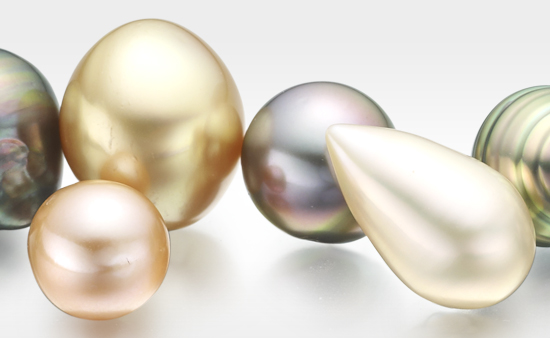
An Introduction to Pearl Colour
WHAT CAUSES A PEARL'S COLOUR?
The physical colour of a pearl is influenced by a number of factors. The colour of the host mollusc's shell, and the genetic fingerprint of its tissue and epithelial cells, gives the greatest clue to a pearl's eventual colour. A classic Akoya pearl, for example, will have a neutral white body colour similar to the shell colour of its oyster and a Tahitian pearl will have the dark tones of the black-lipped Pinctada margaritifera cumingii oyster. Although pearl farmers and scientists have tried to influence the colour of a cultured pearl through the selection of a small piece of mantle tissue for pearl grafting, the specific pearl colour remains somewhat of a mystery until the pearl is fully formed.
The quality of a mollusc's environment can influence its colour and is one reason why pearl farmers are increasingly focused on raising marine environmental awareness. The quality and nutritional content of water directly affects an mollusc's health, its growth rate and the quality of the nacre it produces. If the nacre of a pearl is very thin or of poor quality, the colour of the pearl will appear matt and lack overtones. The striking metallic bronze and green colours of some natural American freshwater pearls, for example, are believed to be a result of trace elements such as copper in the local water systems.
There are many shades of colour-treated pearls available today, including Black Freshwater and Akoya, Grey and Peacock Freshwater pearls, Chocolate, Cherry and Rose. Each of these unnatural colours will have been the result of a colour treatment after the pearl has been cleaned. Some colour treatments such as bleaching and applying a pink tint are so widely used that they are rarely disclosed. Other more significant post-harvesting treatments, however, might include immersion in silver nitrate and irradiation to lighten or darken a pearl's colour.
GRADING PEARL COLOUR
The pearl industry and pearl lovers alike commonly use a variety of terms such as gold, pistachio, lavender to help describe the colour of a pearl. To help standardise how pearls are graded, The Gemological Institute of America (GIA), which led the way in establishing a classification system for diamonds, introduced Color as one of its seven key criteria for grading the quality of pearls.
An expert will assess the colour of each pearl according to a description system that uses 19 different cool and warm colour hues.
Each pearl should have the following three characteristics described, where applicable:
- Bodycolour – the dominant, overall colour of a pearl
- Overtone – some pearls display one or more additional overtones of colour in the reflection near the top of a pearl
- Orient – the rainbow colours that are displayed just below the surface of a pearl, usually those of a baroque shape, as it is rotated
As well as having many years of experience with pearls, the team at Winterson is trained in pearl grading by the GIA. Pearl Colour is one of the value factors that we use to describe the pearl jewellery at Winterson. If you would like to know more about the quality of our pearls, or how we grade them, please do contact us.
WHAT TO LOOK FOR
In our experience the most popular colour of pearls is still white, perhaps matched with the sparkle of a diamond. There are more choices of types of pearl available in this colour, that the size of pearl and an individual's budget start to be a significant decision factor.
The pastel shades of freshwater pearls are beautiful for wearing in the summer. The darker exotic shades of Tahitian pearls are contemporary in style and very elegant for business and evening wear.
Some dyeing treatments can be identified if the pearls are uniformly one colour or at the drill hole where it may be possible to see some residue of dye. A darker nucleus inside the pearl may also be evidence of irradiation treatment. If you are concerned about a pearl's colour, ask your jeweller and look for proper disclosure of colour and other grading factors when buying pearls.
Image Credits:
Copyright of Winterson

